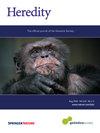二倍体数量减少的甲虫中转座因子衍生的卫星dna的扩增。
IF 3.9
2区 生物学
Q2 ECOLOGY
引用次数: 0
摘要
重复DNA序列在真核生物基因组中普遍存在,显著影响其结构、功能和进化。它们可以促进基因组重排,促进染色体和基因组的多样性。鞘翅目甲虫以其高度多样化的核型和异染色质分布而闻名。在这项研究中,我们进一步了解了卫星dna样序列(在这里仅称为satDNA)与基因组组织/重组之间的复杂关系。我们研究了三种具有不同核型的物种的卫星组,它们经历了独立的染色体融合:Colaspis laeta (2n = 22, Xyp),具有保守的核型;双鼻内脑(2n = 10,新xy);伊菲迈斯俯冲(2n = 14, neo-XY)。我们的比较分析揭示了卫星dna起源、组织和进化的高度不同的模式。在染色体数目减少和新性别染色体的物种中,我们观察到高丰度的转座因子相关(te相关)satdna。在Colaspis laeta中,性染色体(Xyp)表现出高度分化。然而,在二倍体数量减少的物种中,在性染色体中没有观察到这种水平的重复dna的差异富集,表明分化处于早期阶段。我们的研究结果支持了染色体重排和重复DNA序列重组相关的假设,在二倍体数量减少的物种中观察到广泛的重组。此外,这些数据强化了TEs在卫星dna起源中的作用,它可能广泛分布在整个基因组中,包括常染色质区域。这项研究为非模式物种重复dna的进化动力学提供了新的见解,强调了染色体重排对基因组结构和进化的影响。本文章由计算机程序翻译,如有差异,请以英文原文为准。

Expansion of satellite DNAs derived from transposable elements in beetles with reduced diploid numbers
Repetitive DNA sequences are ubiquitous in eukaryotic genomes, significantly influencing their structure, function, and evolution. They can facilitate genomic rearrangements, contributing to chromosomal and genomic diversity. Chrysomelidae (Coleoptera) beetles are known for their highly diverse karyotypes and heterochromatin distribution. In this study, we advanced the understanding of the intricate relationship between satellite DNA-like sequences (named here solely as satDNA) and genome organization/reshuffling using three species of Eumolpinae chrysomelids. We investigated the satellitomes of three species with divergent karyotypes that had undergone independent chromosomal fusions: Colaspis laeta (2n = 22, Xyp), with a conserved karyotype; Endocephalus bigatus (2n = 10, neo-XY); and Iphimeis dives (2n = 14, neo-XY). Our comparative analysis revealed highly divergent patterns of satDNA origin, organization, and evolution. In species with reduced chromosome numbers and neo-sex chromosomes, we observed a high abundance of transposable element-related (TE-related) satDNAs. In Colaspis laeta, the sex chromosomes (Xyp) showed an advanced level of differentiation. However, in the species with a reduction in diploid number, such a level of differential enrichment of repetitive DNAs was not observed in the sex chromosomes, indicating an early stage of differentiation. Our findings support the hypothesis that chromosomal rearrangements and reorganization of repetitive DNA sequences are connected, with extensive reshuffling observed in species with reduced diploid numbers. Moreover, the data reinforce the involvement of TEs in satDNA origin, which could spread widely throughout the genome, including euchromatic areas. This study provides new insights into the evolutionary dynamics of repetitive DNAs in non-model species, emphasizing the impact of chromosomal rearrangements on genome architecture and evolution.
求助全文
通过发布文献求助,成功后即可免费获取论文全文。
去求助
来源期刊

Heredity
生物-进化生物学
CiteScore
7.50
自引率
2.60%
发文量
84
审稿时长
4-8 weeks
期刊介绍:
Heredity is the official journal of the Genetics Society. It covers a broad range of topics within the field of genetics and therefore papers must address conceptual or applied issues of interest to the journal''s wide readership
 求助内容:
求助内容: 应助结果提醒方式:
应助结果提醒方式:


